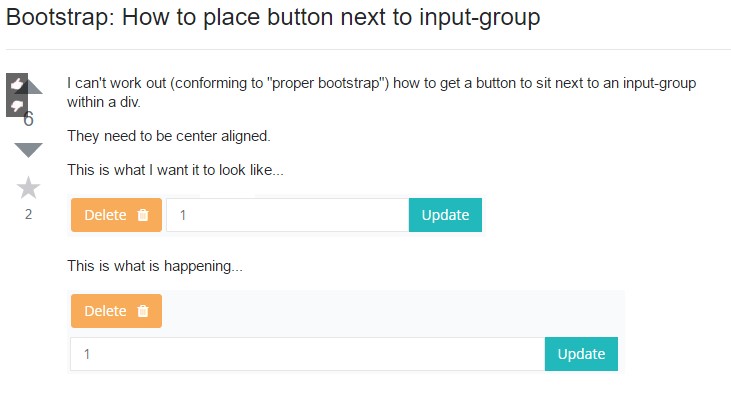Bootstrap Input Validation
Intro
Most of the components we utilize in data sheets to gather site visitor info are from the <input> tag.
You may effectively extend form dominions with including words, tabs, or else button groups on either part of textual <input>-s.
The many different kinds of Bootstrap Input Class are established by value of their option attribute.
Next, we'll describe the accepted options with regard to this particular tag.
Text
<Input type ="text" name ="username">
Quite possibly some of the most common sort of input, which comes with the attribute type ="text", is made use of in the event that we want the user to send a elementary textual data, given that this component does not let the entering of line breaks.
Anytime you are launching the form, the details put in by the site visitor is available on the server side using the "name" attribute, chosen to determine every information featured in the request specifications.
To get access to the details entered when we treat the form with some kind of script, to validate the information for example, it is important to gather the information of the value property of the object in the DOM.
Code
<Input type="password" name="pswd">
Bootstrap Input Style that is given the type="password" attribute is very similar to the text type, besides that it does not display really the message inserted by the site visitor, but instead a set of signs "*" or some other according to the browser and functional system .
Classic Bootstrap Input File good example
Insert one addition either tab on either part of an input. You could also put a single one on each of parts of an input. Bootstrap 4 does not supports a variety of form-controls in a particular input group.
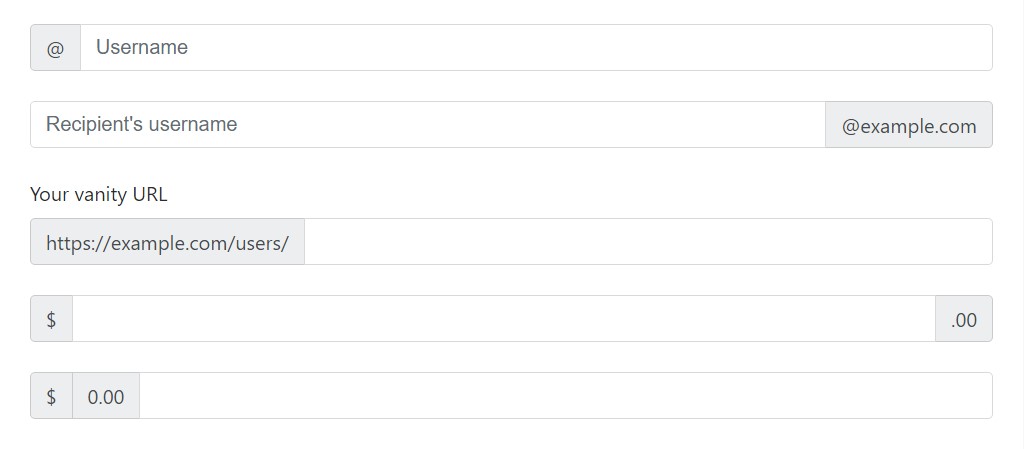
<div class="input-group">
<span class="input-group-addon" id="basic-addon1">@</span>
<input type="text" class="form-control" placeholder="Username" aria-describedby="basic-addon1">
</div>
<br>
<div class="input-group">
<input type="text" class="form-control" placeholder="Recipient's username" aria-describedby="basic-addon2">
<span class="input-group-addon" id="basic-addon2">@example.com</span>
</div>
<br>
<label for="basic-url">Your vanity URL</label>
<div class="input-group">
<span class="input-group-addon" id="basic-addon3">https://example.com/users/</span>
<input type="text" class="form-control" id="basic-url" aria-describedby="basic-addon3">
</div>
<br>
<div class="input-group">
<span class="input-group-addon">$</span>
<input type="text" class="form-control" aria-label="Amount (to the nearest dollar)">
<span class="input-group-addon">.00</span>
</div>
<br>
<div class="input-group">
<span class="input-group-addon">$</span>
<span class="input-group-addon">0.00</span>
<input type="text" class="form-control" aria-label="Amount (to the nearest dollar)">
</div>Sizings
Add in the associated form scale classes to the .input-group in itself and materials inside will immediately resize-- no requirement for reproducing the form control sizing classes on every element.

<div class="input-group input-group-lg">
<span class="input-group-addon" id="sizing-addon1">@</span>
<input type="text" class="form-control" placeholder="Username" aria-describedby="sizing-addon1">
</div>
<br>
<div class="input-group">
<span class="input-group-addon" id="sizing-addon2">@</span>
<input type="text" class="form-control" placeholder="Username" aria-describedby="sizing-addon2">
</div>Place any sort of checkbox or radio possibility inside of an input group’s addon as an alternative to of text.
Checkbox button solution
The input element of the checkbox variation is really oftentimes used whenever we have an feature which can possibly be marked as yes or no, such as "I accept the terms of the user contract", or perhaps "Keep the active program" in applications Login.
Widely used with the value true, you can certainly identify any value for the checkbox.

<div class="col-lg-6">
<div class="input-group">
<span class="input-group-addon">
<input type="checkbox" aria-label="Checkbox for following text input">
</span>
<input type="text" class="form-control" aria-label="Text input with checkbox">
</div>
</div>Radio button option
We can easily put to work input features of the radio option whenever we would like the user to go for just one of a series of opportunities.
Only one particular might be selected when there is more than one element of this particular style by using the similar value in the name attribute.

<div class="col-lg-6">
<div class="input-group">
<span class="input-group-addon">
<input type="radio" aria-label="Radio button for following text input">
</span>
<input type="text" class="form-control" aria-label="Text input with radio button">
</div>
</div>Numerous addons
Multiple attachments are promoted and can be put together along with checkbox and also radio input versions.

<div class="row">
<div class="col-lg-6">
<div class="input-group">
<span class="input-group-addon">
<input type="checkbox" aria-label="Checkbox for following text input">
</span>
<span class="input-group-addon">$</span>
<input type="text" class="form-control" aria-label="Text input with checkbox">
</div>
</div>
<div class="col-lg-6">
<div class="input-group">
<span class="input-group-addon">$</span>
<span class="input-group-addon">0.00</span>
<input type="text" class="form-control" aria-label="Text input with radio button">
</div>
</div>
</div>Input group: different buttons variances
<Input type ="button" name ="show_dialogue" value ="Click here!">
The input element together with the type="button" attribute puts a tab inside the form, on the other hand this tab has no direct function with it and is often utilized to generate events regarding script performance.
The button text message is detected with value of the "value" attribute.
Add-ons of the buttons
Buttons in input groups have to be covered in a .input-group-btn for appropriate placement as well as proportions. This is demanded because of the default web browser styles that can definitely not be overridden.

<div class="row">
<div class="col-lg-6">
<div class="input-group">
<span class="input-group-btn">
<button class="btn btn-secondary" type="button">Go!</button>
</span>
<input type="text" class="form-control" placeholder="Search for...">
</div>
</div>
<div class="col-lg-6">
<div class="input-group">
<input type="text" class="form-control" placeholder="Search for...">
<span class="input-group-btn">
<button class="btn btn-secondary" type="button">Go!</button>
</span>
</div>
</div>
</div>
<br>
<div class="row">
<div class="col-lg-offset-3 col-lg-6">
<div class="input-group">
<span class="input-group-btn">
<button class="btn btn-secondary" type="button">Hate it</button>
</span>
<input type="text" class="form-control" placeholder="Product name">
<span class="input-group-btn">
<button class="btn btn-secondary" type="button">Love it</button>
</span>
</div>
</div>
</div>Drop-down buttons

<div class="row">
<div class="col-lg-6">
<div class="input-group">
<div class="input-group-btn">
<button type="button" class="btn btn-secondary dropdown-toggle" data-toggle="dropdown" aria-haspopup="true" aria-expanded="false">
Action
</button>
<div class="dropdown-menu">
<a class="dropdown-item" href="#">Action</a>
<a class="dropdown-item" href="#">Another action</a>
<a class="dropdown-item" href="#">Something else here</a>
<div role="separator" class="dropdown-divider"></div>
<a class="dropdown-item" href="#">Separated link</a>
</div>
</div>
<input type="text" class="form-control" aria-label="Text input with dropdown button">
</div>
</div>
<div class="col-lg-6">
<div class="input-group">
<input type="text" class="form-control" aria-label="Text input with dropdown button">
<div class="input-group-btn">
<button type="button" class="btn btn-secondary dropdown-toggle" data-toggle="dropdown" aria-haspopup="true" aria-expanded="false">
Action
</button>
<div class="dropdown-menu dropdown-menu-right">
<a class="dropdown-item" href="#">Action</a>
<a class="dropdown-item" href="#">Another action</a>
<a class="dropdown-item" href="#">Something else here</a>
<div role="separator" class="dropdown-divider"></div>
<a class="dropdown-item" href="#">Separated link</a>
</div>
</div>
</div>
</div>
</div>More than that, buttons can be fractional
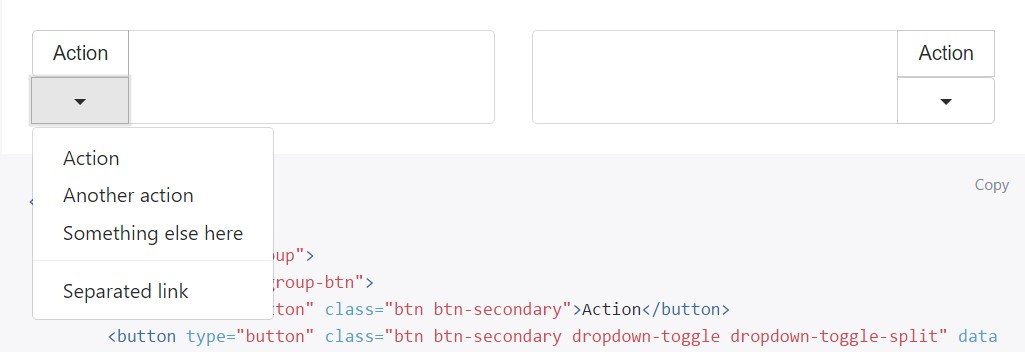
<div class="row">
<div class="col-lg-6">
<div class="input-group">
<div class="input-group-btn">
<button type="button" class="btn btn-secondary">Action</button>
<button type="button" class="btn btn-secondary dropdown-toggle dropdown-toggle-split" data-toggle="dropdown" aria-haspopup="true" aria-expanded="false">
<span class="sr-only">Toggle Dropdown</span>
</button>
<div class="dropdown-menu">
<a class="dropdown-item" href="#">Action</a>
<a class="dropdown-item" href="#">Another action</a>
<a class="dropdown-item" href="#">Something else here</a>
<div role="separator" class="dropdown-divider"></div>
<a class="dropdown-item" href="#">Separated link</a>
</div>
</div>
<input type="text" class="form-control" aria-label="Text input with segmented button dropdown">
</div>
</div>
<div class="col-lg-6">
<div class="input-group">
<input type="text" class="form-control" aria-label="Text input with segmented button dropdown">
<div class="input-group-btn">
<button type="button" class="btn btn-secondary">Action</button>
<button type="button" class="btn btn-secondary dropdown-toggle dropdown-toggle-split" data-toggle="dropdown" aria-haspopup="true" aria-expanded="false">
<span class="sr-only">Toggle Dropdown</span>
</button>
<div class="dropdown-menu dropdown-menu-right">
<a class="dropdown-item" href="#">Action</a>
<a class="dropdown-item" href="#">Another action</a>
<a class="dropdown-item" href="#">Something else here</a>
<div role="separator" class="dropdown-divider"></div>
<a class="dropdown-item" href="#">Separated link</a>
</div>
</div>
</div>
</div>
</div>Submit
<Input type ="submit" name ="send" value ="Submit">
The input element together with the form "submit" attribute is very close to the button, but when triggered this particular feature starts the call that provides the form data to the address revealed in the action attribute of <form>.
Image
You are able to substitute the submit form tab by using an image, making it feasible to generate a even more appealing style to the form.
Reset
<Input type="reset" name="reset" value="Clear">
The input with type="reset" abolishes the values recorded once in the features of a form, allowing the site visitor to clear up the form.
<Input> and <button>
<Button type="button" name="send"> Click here </button>
The <input> tag of the tab, submit, and reset options can be replaced with <button> tag.
In this situation, the message of the tab is currently specified as the material of the tag.
It is still necessary to define the value of the type attribute, even if it is a button.
File
<Input type ="file" name ="attachment">
If it is crucial for the user to send out a file to the program on the server area, it is important to use the file type input.
For the flawless providing of the data, it is usually in addition necessary to add in the enctype="multipart/form-data" attribute in the <form> tag.
Hidden
<Input type="hidden" name ="code" value ="abc">
Quite often we want to receive and send information which is of no straight use to the user and as a result should not be presented on the form.
For this kind of goal, there is the input of the hidden type, which only brings a value.
Availableness
Screen readers will definitely have difficulty with your forms assuming that you don't provide a label for every input. For these particular input groups, be sure that any type of extra label or function is conveyed to assistive technologies.
The examples in this section provide a few suggested, case-specific approaches.
Examine a couple of on-line video tutorials relating to Bootstrap Input
Related topics:
Bootstrap input:official documents
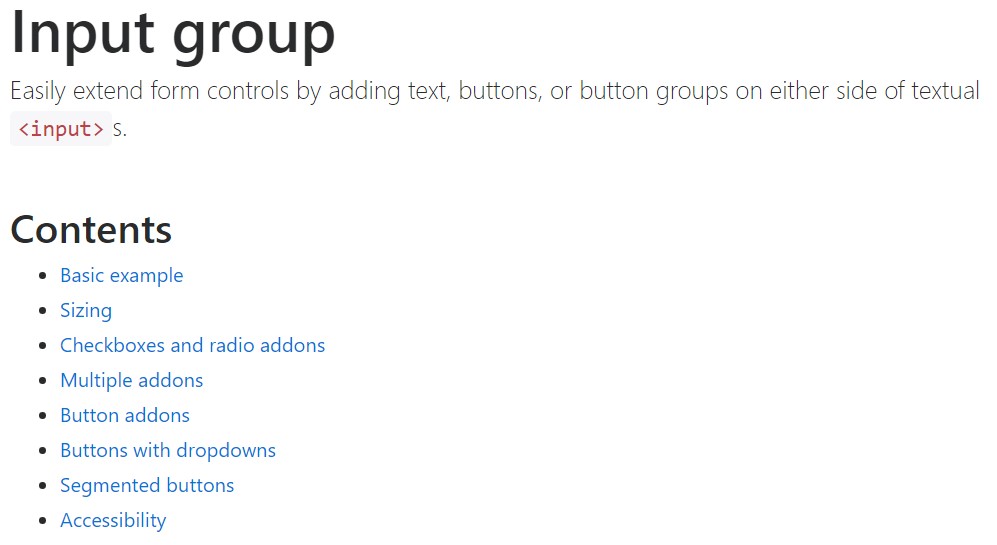
Bootstrap input article
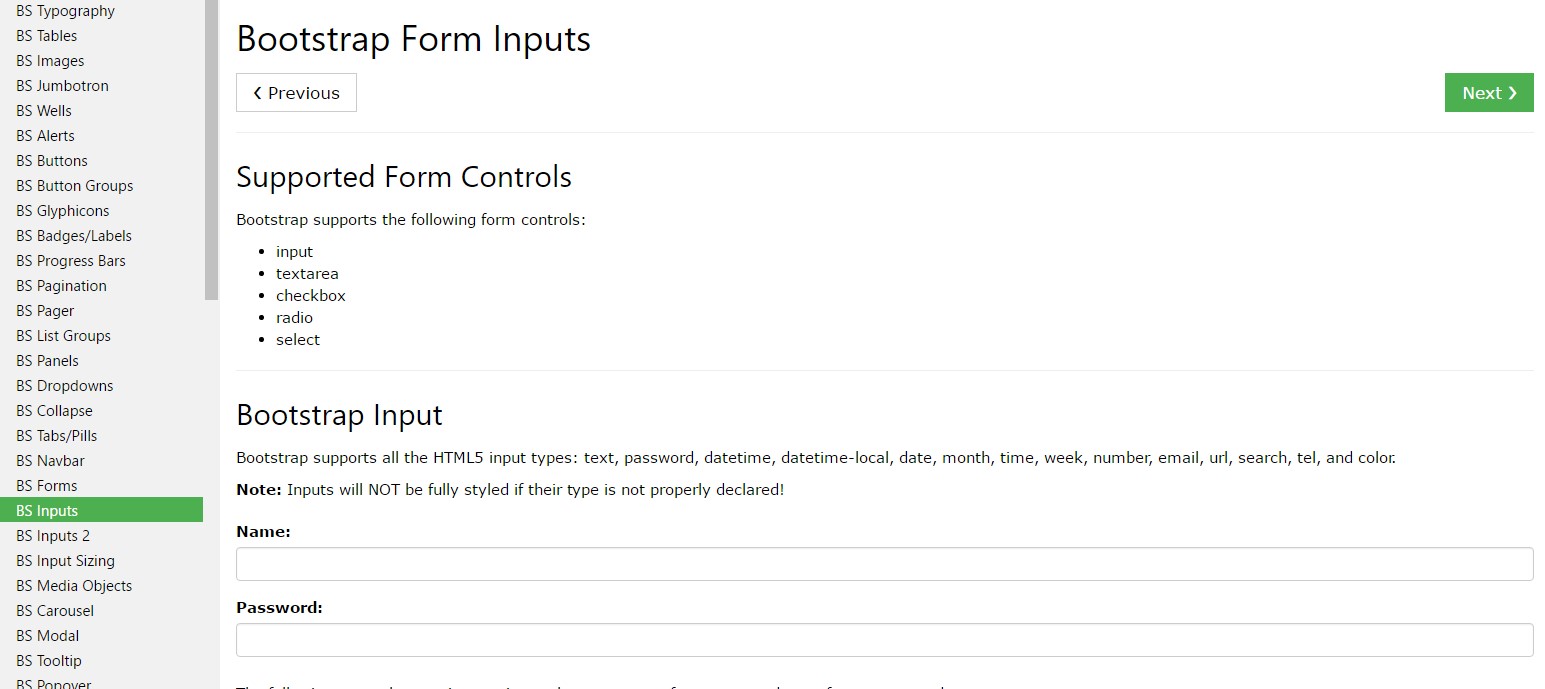
Bootstrap: The ways to set button next to input-group
